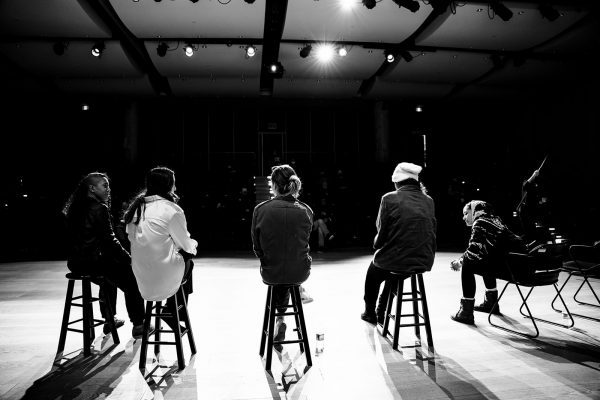Thunderous applause. The woman in front of me wipes tears from her eyes. The noise of the audience is overwhelming, and my own catharsis is palpable. My mind struggles to catch up with this unexpected rush of emotion. I am on my feet, applauding, startled. I cannot remember the last time ballet made me feel this way.
This emotional response was generated by The Man in Black, part of a mixed bill presented by The National Ballet of Canada (NBoC). Four distinct ballet works showcased an extraordinary artistic range. Artistic Director Karen Kain masterfully curated a program to please traditionalists while satisfying a need for audacious and contemporary ballet.
The evening began with George Balanchine’s classically beautiful Allegro Brillante. One of the great choreographers of the twentieth century, Balanchine had a tremendous influence on the evolution of ballet. This work is a sparkling interpretation of Tchaikovsky’s Piano Concerto No. 3. It was executed with contagious joy and ecstatic precision by soloists Elena Lobsanova and Francesco Gabriele Frola on March 6. The lightness and freshness of this work served as a satisfying aperitif. Next on the program was a gentle diversion from pure movement, a nod to musical theatre in Christopher Wheeldon’s Carousel. Wheeldon is an internationally acclaimed choreographer with a transatlantic career, working in both North America and England. His 2011 work Alice’s Adventures in Wonderland is also part of the NBoC’s 2014-2015 program. Carousel cleverly employs a corps de ballet to embody the carnival ride while soloists portray innocent young lovers caught in their own metaphorical highs and lows. Carousel is bittersweet; lovers embrace with passion and longing, the corps waltzes ever faster, the dancers’ bodies suspend in defiance of gravity and wait, breathless, for the inevitable fall.
While Carousel and Allegro Brillante were glittering divertissements, the two pieces that followed were more contemporary; utterly riveting and deeply influenced by current society. Kudelka’s The Man in Black is a haunting, subtly harrowing portrait of country musician Johnny Cash’s internal landscape. This landscape is dark — there is no sunlight, no evening glow. Black wings and a dark cyclorama frame the four dancers, three men and a woman. They move in this void, smoothly transitioning from one sculptural image to the next, scuffing their cowboy boots in rhythmic patterns derived from line dancing. Their movements are heavy, full of resistance and effort. The dancers form dissolving tableaus, which evolve and re-emerge. They interpret six covers sung by Johnny Cash toward the end of his career. These songs are coarsely resonant, full of an urgent, grating elegance, suggesting the presence of death. The movement, too, is urgent, possessed of a world-weary sorrow and heaviness. The dancers’ power to endure this heaviness lends them deep human strength, a battered beauty devoid of the melodrama common to many traditional ballets. Artistic director of the NBoC for nine years, James Kudelka abruptly broke with ballet, recently re-emerging as a choreographer after a stint working in a bakery in a rural town. Kudelka’s choreography paints the image of a man alone, isolated by his genius, struggling with his own success. While there are parallels here, The Man in Black ultimately surpasses its own portraiture. It is a heartbreaking search to make meaning from suffering; an examination of the dark places of the human soul and a plea for redemption and light.
Chroma by contrast, was a play of subtle colour in a painfully white space. The most choreographically dense piece of the mixed program, Chroma was created for the Royal Ballet and premiered at the Royal Opera House in 2006. This work was choreographed by dance superstar Wayne McGregor. McGregor moves easily between stage and film (he choreographed two music videos for Radiohead and was movement director for Harry Potter and the Goblet of Fire), and is the artistic director of Random Dance as well as resident choreographer with the Royal Ballet. While Chroma masterfully utilizes the ensemble, it relies on the unique talent of individual dancers. Dylan Tedaldi continuously drew the eye with his confidence and stable presence, remaining clean and precise despite the rigorously fast contortions of the choreography. Tedaldi was double cast, while Svetlana Lunkina appeared on March 6. Lunkina was a superhuman apparition, her lithe, muscular form extending from the thin sheath of her costume, mobile limbs hyperextending, spine undulating. The ensemble twisted and undulated with muscular force and authoritative conviction, seemingly driven by Joby Talbot’s musical score. Talbot arranged music by Jack White alongside his own acerbic compositions to create a visceral, powerful sound. These abstractly aggressive movements and the violently energetic music contrast with the clean white space designed by architect John Pawson. Pawson’s minimalist cool cube highlights the temperature of the dancers, the sense of their skin touching, their muscular effort. His white walls emphasize the dancers’ skin pigmentation and neutral costumes. Chroma is a dance of unresolved contrast — at once three dimensional and flat, colourful and colourless, hot and cold, aggressively passionate and mechanically detached. From these paradoxical states a vastly intelligent, oxymoronic world emerges, full of tensions that resonate long after the work has concluded.
The NBoC’s mixed bill showcased diverse artistic voices in a range of styles. The audience was treated to Allegro Brillante’s brightness, Carousel’s twilight carnival, The Man in Black’s sombre void and Chroma’s abstract and potent play of contrast. The program was masterful, sure to satisfy traditionalists while proving Toronto has a vast appetite for risk-taking, provocative ballet.
Tagged: Ballet, Choreography, Contemporary, Emerging Arts Critics Programme, Performance, ON , Toronto





